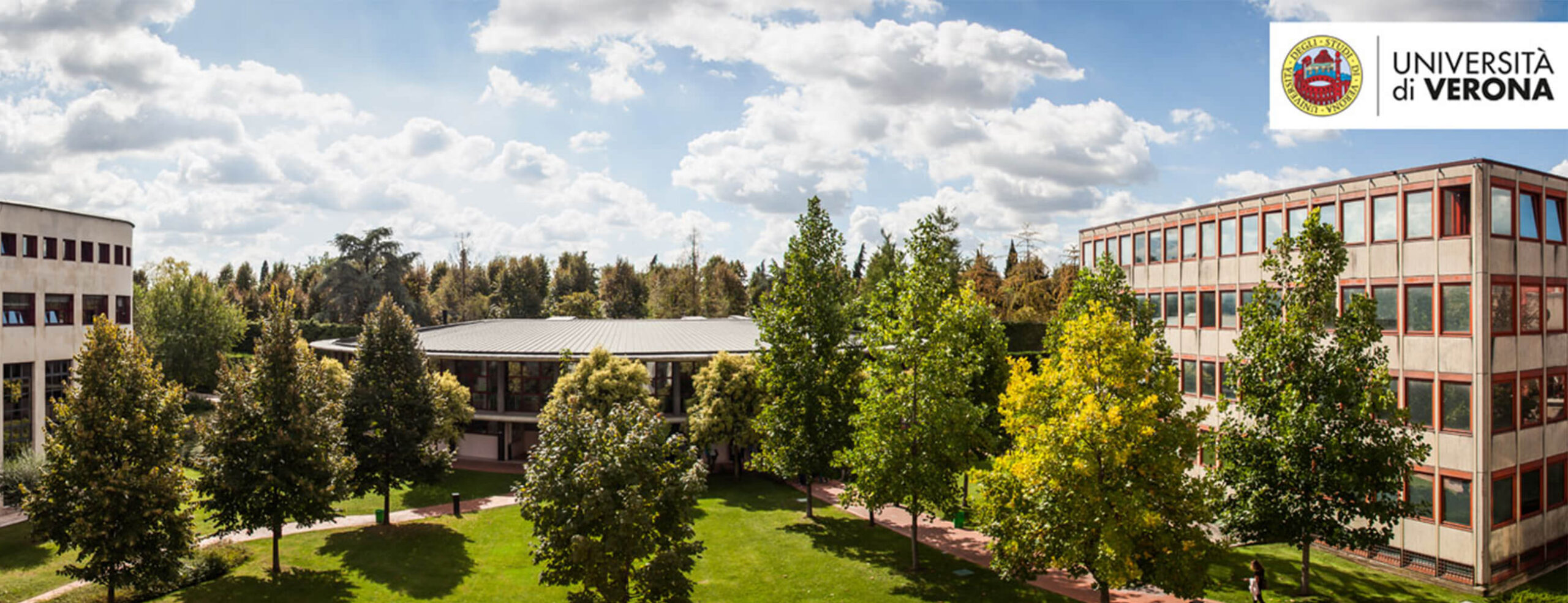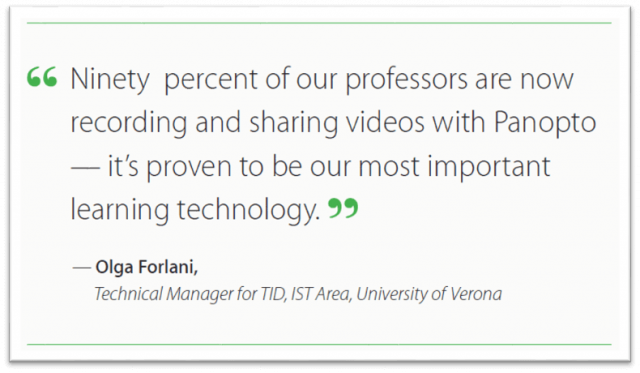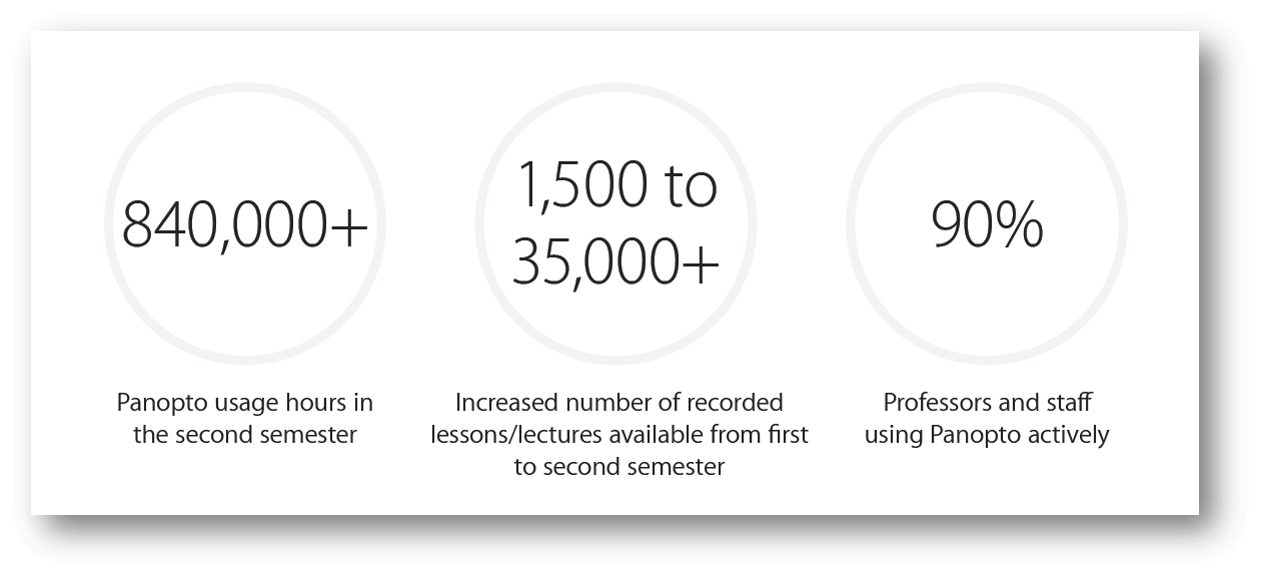- Academic Technology
Learning Under Lockdown At University Of Verona

Two years ago, no one was thinking about preparing for a pandemic when leaders on the e-learning technology team (Tecnologie Innovative per la Didattica, or TID) within the Information Systems and Technology (IST) Area at the University of Verona first began an initiative to upgrade the university’s core learning technologies.
The digital technologies for video management that supported learning at University of Verona up until that point had been largely reliant on expensive, rigid, hardware-based systems inside campus classrooms. But in 2018, Silvano Pasquali, Head of the TID team, saw an opportunity to not only reduce the university’s operating costs by shifting to more affordable, easy-to-upgrade software-based video solutions, but to also better support the needs of the campus community.
Pasquali and his TID teammates, Sara Ceglie, Pierpaolo (Pier) Morandini and Olga Forlani, immediately set out to create a new, integrated learning technology ecosystem that would both enable innovations in teaching and learning and expand the use of digital learning technologies across campus.
The TID team would come to learn they had, in fact, built a system that could do much more than they originally planned. Their integrated ecosystem of learning technologies — Panopto, Moodle, and Zoom — would enable the University of Verona to tackle a crisis for which most other universities in Italy were unprepared.
In March of 2020, Italy imposed a national quarantine, ordering approximately 60 million people into lockdown in an effort to slow the spread of the COVID-19 pandemic. While students at many other Italian universities experienced cancelled classes and significant disruptions to academics, University of Verona’s students were able to continue the semester online without interruption.
The learning technology ecosystem:
An Integrated Solution Powered by Panopto
There were three main technology systems the team at the University of Verona determined it needed to meet the needs of the campus: A learning management system (LMS) would serve as the central hub for course management and communications, a video conferencing solution would enable live online video communications, and a video management system would complete their toolset for capturing and managing a growing library of on-demand videos. When integrated into one seamless learning ecosystem, professors would gain the ability to explore new teaching methodologies that support better student outcomes.
The University of Verona had previously adopted Moodle as its LMS and was already using Zoom for live video conferencing. Both of those systems could be managed and used from anywhere. But professors still had to physically be in the classroom on campus to record a lecture video. And with limited classrooms equipped for lecture capture, booking time to record course videos outside of scheduled class time was often difficult, and sometimes impossible.
The TID team went searching for a software-centric video capture solution that would give professors more flexibility to record videos anytime, from anywhere. That meant that the solution needed to be easy enough for anyone to use, and sharing videos with students also had to be effortless.
After comparing several solutions on the market, the team at the University of Verona decided that Panopto was the right video management system to complete its learning technology stack. “Panopto was our first choice for a number of reasons, including its ease-of-use, its built-in integrations for other technologies we already used, and because the people behind the software really impressed us,” said Pasquali.

Panopto was an essential component of the learning ecosystem at the University of Verona — not only did Panopto greatly expand video recording capabilities so educators were empowered to explore new pedagogies, but the university was also able to automate workflows to deliver video content securely to students via their LMS and manage the system remotely. What’s more, professors were able to begin using the new system, which they found to be both helpful and easy to use, after just one hour-long workshop on using Panopto and Moodle.
“Professors want to ensure that their course content is available exclusively to their students,” explained Pierpaolo Morandini, TID Technical Manager. “With Panopto’s Moodle integration, we automatically provision and upload recordings that are only visible to the students enrolled in the course, so professors have no doubt their lessons are protected. Live sessions recorded in Zoom are also captured by Panopto and published securely to Moodle,” he said.
Olga Forlani, Technical Manager for TID, added that professors also rely on video analytics from Panopto to better understand how students interact with their recordings. “Monitoring the activity and engagement is important for addressing the needs of individual students, assessing course content, and revising future lesson plans,” said Forlani.
The University of Verona was the first university in Italy to deploy Panopto, and looking back, Pasquali said they could not have felt more confident in their partnership from day one. “Panopto is built and managed end-to-end by the same team in-house. Other video platforms consist of third-party solutions, which can make troubleshooting much more challenging,” he explained. Reflecting on his experiences collaborating with Panopto, Pasquali added, “When I call Panopto, they listen to our feedback and work hard to support us.”
The unexpected challenge:
Maintain the Continuity of Education Through a Pandemic
In early 2020, universities across Italy were caught off-guard when a public health crisis caused by an infectious and deadly coronavirus forced the entire country into lockdown. As students returned home from their closed campuses, the TID team reacted quickly and began working to ensure that the University of Verona’s students would be able to continue their education online.
One thing was certain early on — the university’s early adoption of the right mix of learning technologies had set them up for success. “We felt prepared,” said Pasquali. “Though we did not anticipate the pandemic, we knew that our learning technology ecosystem could support us in the transition to online learning.”
With their learning technologies already in place, the TID team immediately set up daily workshops through Zoom to provide additional training to professors that would support them in the quick shift to teaching online. Because their technologies simply worked and many educators on campus had prior experience using them already, the pandemic did not stop learning at the University of Verona.
 It was clear to the TID team that other universities were not as well prepared as they were. “Other universities had real challenges adapting to online learning. We saw teachers and students at other schools just sharing links on Facebook and YouTube where anyone could view the lecture videos,” said Morandini. Both professors and students at the University of Verona were thankful their valuable learning resources were secured and could not be shared freely.
It was clear to the TID team that other universities were not as well prepared as they were. “Other universities had real challenges adapting to online learning. We saw teachers and students at other schools just sharing links on Facebook and YouTube where anyone could view the lecture videos,” said Morandini. Both professors and students at the University of Verona were thankful their valuable learning resources were secured and could not be shared freely.
“If it weren’t for Panopto, our academic year would have been at risk,” said Forlani. “Ninety percent of our professors are now recording and sharing videos with Panopto — it’s proven to be our most important learning technology. Even professors teaching through Zoom rely on Panopto to share recordings of their live sessions,” she said.
Pivoting to online learning in the middle of the academic year was no easy feat, but the data highlights the university’s significant accomplishments. The number of recorded lectures captured with Panopto grew by 266% compared to the previous semester. “Growth and usage of Panopto has been exponential this semester,” said Morandini. With close to 950 professors and over 1,200 courses available, the university recorded more than 35,000 course videos and saw an excess of 840,000 usage hours from its 21,000 students in the second semester alone. “We hit 1,000 usage hours in one day!” added Lucia Forlani.

Looking ahead:
A Permanent Change in Teaching and Learning
For the University of Verona, teaching and learning will be forever changed by the coronavirus pandemic.
“People are realizing it’s so easy to simply press a button and record,” said Pasquali. Using the technologies and seeing the possibilities, even under such challenging circumstances, has started to reshape the way educators on campus think about conducting lessons. And as the reaction to the initial crisis fades and educators settle into a new normal, the TID team expects many professors will continue using the technologies and teaching methodologies that may have been new to them at the start of the pandemic.
For example, some educators at the University of Verona are using the flipped classroom model to better support remote students through the pandemic. In the flipped classroom, students watch pre-recorded, on-demand lecture videos before live, interactive virtual class sessions, so the time with their professor and classmates can be spent engaged in active learning. This helps improve remote students’ comprehension of new subjects and also supports knowledge retention — and it gives both students and faculty a little more flexibility.
“Panopto is one of the most powerful tools to support this new way of teaching,” said Pasquali. “We’ve already heard from faculty who say they plan to improve flipping their classrooms even after the pandemic.”
If anything, being prepared with their learning technology ecosystem before the crisis accelerated a transformation at the University of Verona that would have likely happened more slowly over the course of several years.
About the University of Verona
The University of Verona strives for excellence in teaching, research, and innovation. It has over 23,000 students and 1,500 staff including lecturers, researchers, and technical and administrative personnel who work to continually improve and grow the university. This forward-thinking institution is dedicated to adapting teaching and learning to its students’ needs and continuously seeks to align its degree programs with the real world of work.
To learn more about Panopto and what your institution can do with it, contact our team for a customized demo.




